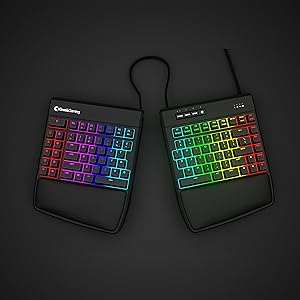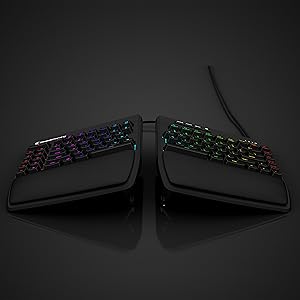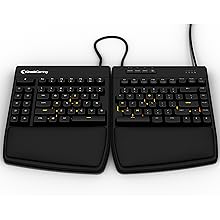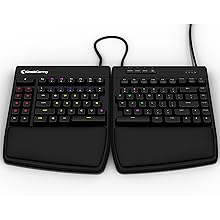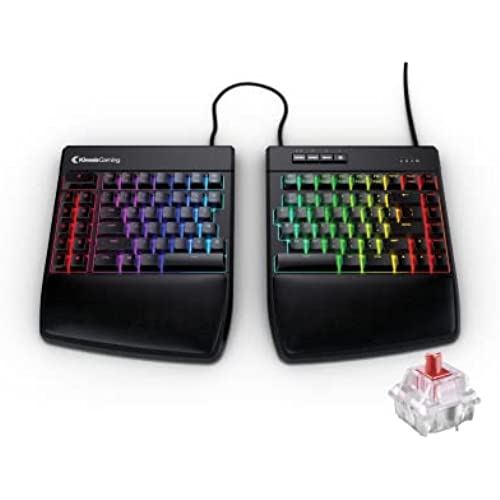
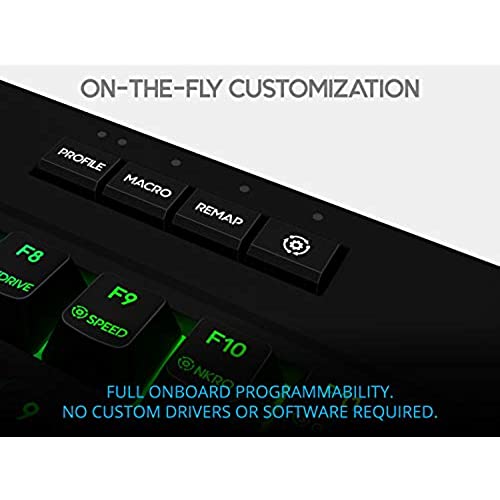
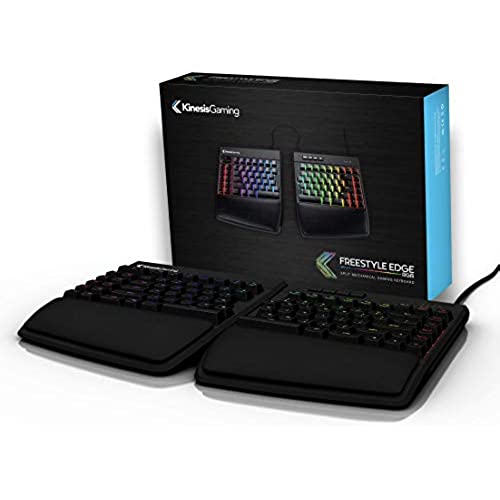

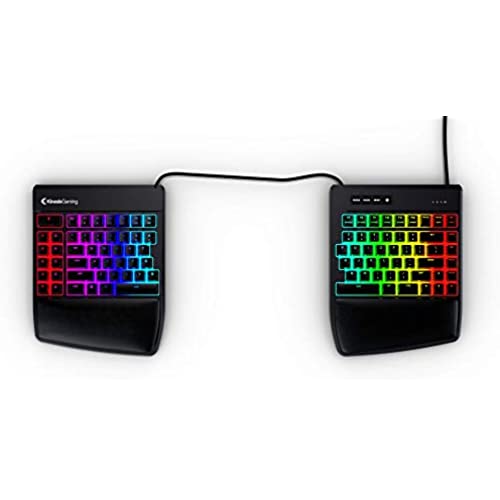
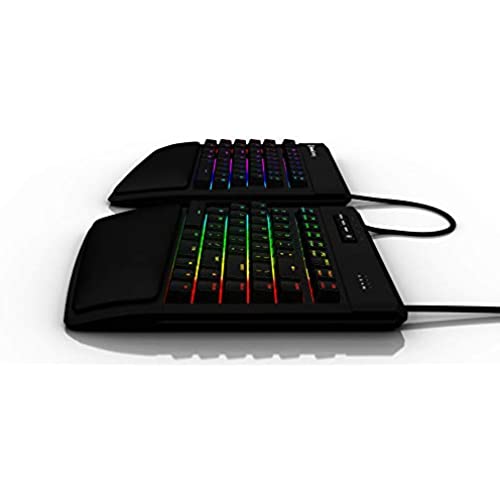
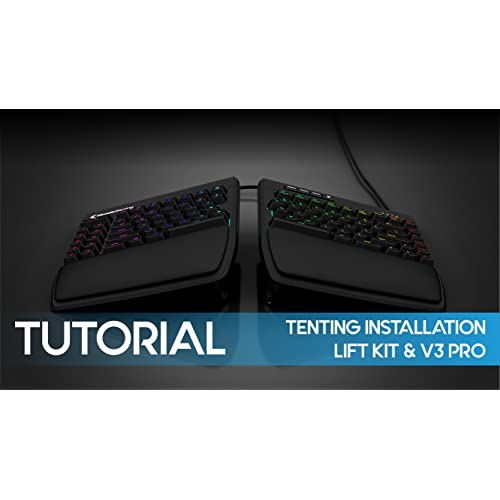















KINESIS Gaming Freestyle Edge RGB Split Mechanical Keyboard | Cherry MX Linear Red Switches | RGB | Ergonomic | Detachable Palm Support | Fully Programmable | TKL | Available Tenting
-

Craig Donovan
> 3 dayAlthough I am a gamer and would have purchased this keyboard for home, the price point was too high. I purchased this keyboard for software development at work because I need a ergo keyboard with reliable keys that can take lots of typing. This is my 3rd keyboard in 4 years and hoping its the last. PROS: Cherry brown key switches are a joy to type on. The control software does NOT require admin privileges so I got the software installed without an IT ticket. The software runs like a USB application, copy the files anywhere on C: and run. The adjustable height, with the optional legs, work pretty well, even though I think for this price point they should have been included. Macro keys are great for small snipets of code like DOxygen comments, etc. I also like the fact that the keyboard itself stores the color profiles and macros internally and allows the end user to manually edit them. This comes in handy because the software option to record a macro is a bit clumsy for anything more than a few characters. The light affects can also be manually adjusted in a text file which is handy. CONS: I really dont like the position of the DEL key in the upper right corner even though I am getting used to it now. I would have preferred a wider foot print with the standard 2x6 (INS,DEL,HOME,END,PGUP,PGDWN) above the cursor keys to the left of the 10 key. The only real issue is with a weird key repeat problem I had with the original firmware(or the previous FW to Decs 2020 release). Several times an hour, a single key would just start repeating forever, even though I removed my hands from the key. I had to type another key to stop it, then delete the string of chars. That was getting old fast. Luckily the latest firmware seems to have addressed most of this issue, so now it only happens once or twice a day. If I were using this in a game however, I suspect it would caused multiple deaths during gameplay. NOT REALLY A CON but: Configuring the keyboard requires a strange procedure that I have never seen in any Windows device. Using a key combination the user basically takes the keyboard offline so that Windows will then see the internal flash drive where all the configs and settings are. Then it checks to see if the configuation utilty is running. Once the app is running the keyboard is not really a keyboard anymore but a flash drive instead. While in the app you can set macros and change the keycap colors / schemes. When done, you do the same key combination to exit the configuration setup and return the device to a keyboard. Its weird, but it works.
-

Heinyken
> 3 dayTL;DR: I was very hesitant to spend the money and risk the loss of typing speed, but Im really happy with the keyboard and strongly recommend it for ergonomics. Im work exclusively from home at my computer, and I bought this keyboard after realizing I was spending too much time in a pretty bad posture for my upper back, neck, arms and wrists. My concerns before buying it were that Im a fast typist (+100WPM) and am a writer/editor, so a shift to my writing set-up could be really bad for my work and efficiency. I mean, Ive been writing on a standard keyboard for 30+ years! Its well beyond muscle memory at this point: its ingrained deep into my brain how my hands go on a keyboard. Also $200 is nothing to sneeze at. Even after 2 weeks of habitually missing the b key, Im happy to report Im VERY happy with the product. My hands, wrists, arms and upper back feel better, and my typing has not only returned to its previous speeds, but has probably improved. Im still working on my accuracy, but its improving rapidly. (the location of Delete, Home & End is particularly hard to get accustomed to.) For gaming, I thought that the recommendation to put the mouse in-between the two halves of the keyboard was a silly one. I was wrong. Its a huge improvement and lets me position my wrist at a 45-degree angle thats much more natural and accurate. Also: strongly recommend the (separately sold) tent/lifters. I was also very hesitant to purchase those and am really glad with them. But seriously: why not have B on both the right and the left half of the keyboard?
-

bigcindy
> 3 dayThis keyboard greatly helped with my RSI. I love the adjustable tilt and adjustable angle between the two halves. Keys have great tactile feel and clickiness. Four months after receiving it, a group of keys started to intermittently fail. At first they would go out for minutes at a time but would come back after fiddling with the board. The problem got worse over the next month and now it looks like theyve stopped working entirely. It took a couple rounds with tech support with them asking me to troubleshoot various things before they agreed it was a hardware issue and offered to replace the keyboard. My only problem with this is that they are making me pay the return shipping. So one star off for the service. Otherwise when the board is working I give it 5 stars. Update: After discovering that it would cost $20 to ship the keyboard back, I contacted the company and they agreed to send a shipping label. Changing my rating from 4 stars to 5. Ill revise my review if I have any issues with the replacement. I hope the bad board was a one-off since Ive now bought a second keyboard for my desk at work.
-

Michael Pohoreski
06-06-2025I _really_ wanted to love this keyboard for there are numerous design flaws that make this keyboard 1/5: === The Ugly === * It does NOT have n-key rollover (NKRO). For gaming this makes this keyboard completely useless. * The symbols are on the bottom of the keys instead of the top?!?!?! Who the heck thought this was a good idea??? When you reach for a number your fingertips cover the bottom half of the key _completely_ obscuring the symbols!! * The palm wrists are TOO short. I always feel like my wrists want to fall off instead of properly being supported. === The Good === * Split keyboard is very, very nice for your hands. * Keys feel very comfortable. * The Brown MX keys feel good. * Extra function keys on the left side are great. * Can individually customize the color of EACH key. Want to have WASD in a different color? No problem! * Dedicated profile button to switch profiles on the fly is great. * Can program any key to turn the keyboard RGB lights completely off. * Cables are heavy braided === The Bad === * ESC key is TOO far away. If you use this for Vi/Vim get used to Ctrl-C. * Ive never seen an ergonomic keyboard that doubles up the two middle keys. Ideally, the YHN would also be doubled up on the left, and TGB would be doubled up on the right. This is yet-another-keyboard out-of-touch with a gamers actual needs in spite of calling itself a gaming keyboard. * Lacks dedicated INS key. Having to press a FN+PAUSE for insert is annoying. * Lacks classic 3x2 Ins/Del/Home/End/PgUp/PgDn layout. Instead the keyboard has the standard vertical line of Del/Home/End/PgUp/PgDn -- which may feel awkward. I never could get used to this vertical strip. * Lack of a dedicated numeric keypad. If you are paying $200 for a keyboard why do you have to spend even more money to get a numeric keypad? === Misc. === Build quality is OK. It doesnt feel cheap, nor expensive. The braided cables are positive build quality, the the short and flimsy wrist pads are negative build quality. (I have a DAS keyboard that is solid and built like a tank.) The sound is not quiet, but also not loud. This didnt bother me but if you work in an office with others this may be a consideration. Ive used this keyboard for 11 months doing hard-core programming and gaming with it because I really, really, wanted to love this keyboard. The comfort and split keyboard are why I kept using it but the numerous design flaws are the straw that broke the camels back. I ended up going with a DAS Keyboard 4 Professional after test driving it for work. === Ratings === Ergonomics: 3/5 Gaming: 0/5 Build Quality: 3.5/5 Final Scores: 1/5 If Kinesis could fix the issues and lower the price they would have a real winner on their hands but until they do look for another keyboard that has all the features you need.
-

Ms. Providenci Kozey IV
> 3 dayI bought this keyboard for business. I am not a gamer. I love the fact that its corded, as I have a habit of dropping wireless items on the ground. I love that it feels solid, not flimsy. This would travel better than longer keyboards, since it would fit into most bags. The colors are gorgeous, but lets continue on functionality. I studied and the Cherry MX red keys are supposed to be both quiet and tactile, allowing me to enjoy typing 70WPM. Thats what the experts say. Well, I enjoy the typing, but it is certainly not a quiet keyboard. Im keeping it anyway, hoping that folks on Zoom meetings wont notice or hear the clicking. One more thing: I either hit the right key combo in error, or it happened on its own, but one of the keys remapped. The letter k stopped typing k and instead was typing o. This cannot be resolved through Windows keyboard troubleshooter. It happened 1 week after my purchase and, with much exploration, I found the answer taped to the underside of the keyboard. Press 3 keys together (I forget which) to restore factory defaults. This cleared the problem. Heres the thing, though: My first stop was Amazon help. The person was helpful, but it took too long. Naturally--hes supporting a million products and is counting on knowledge articles. Its not his baby. Secondly, both he and Google encouraged me to download an app that works with the keyboard. I couldnt download it. To download, they want you to type the model # into a field. They even tell you where to find the model #. Well, I typed it and the page told me it was wrong, and would not let me go further. This is still an open issue.
-

Ian
> 3 dayI really like this keyboard. I changed from Das and magic keyboard. The big upside is the comfort and integrated palm rests. I did purchase the extra kit to have the tenting setup. I dont really game, so cannot comment. There are a couple downsides: Sometimes there is a small ping noise depending on how you hit the key. It does take up quite a bit of room on my desk. The escape key feels way too far away.
-

Jaawn
> 3 dayThere are not very many options for an ergonomic keyboard that has tenting, mechanical switches, and backlighting, but so far I am very happy with this one. I think the price is too high, and the tenting solution should be included, but the end result is one Im happy with. There are a few other nitpicks with key placements, and secondary functions being printed lower on the keys, but those are minor and the pros definitely outweigh the cons for me.
-

Zach
> 3 dayI was having really bad wrist pains from using a plain old Macbook keyboard at work and a classic full keyboard at home. I decided to go in on a split keyboard to try to ease that pain, and it has helped immensely. My wrists _and_ my shoulders feel much better after a few months of use. The key macro and rebinding features are great. I work from home and switch the keyboard between a macbook and a windows PC. Having two different profiles is amazing and it was very easy to set up. Apparently, the Mac setup software does not run on Catalina now but I can set it up on my Windows PC so all is not lost. The light rebinding is really nice too, though the quality of the individual lights didnt quite live up to my expectations (which were admittedly sky high). Still though, they serve their purpose. For example, I have HJKL colored green on my Work profile for Vim, QWER/WASD colored special on my gaming profile. I have caps lock bound to escape and colored them both the same to remind me. Just all around really helpful to be able to rebind keys and recolor them too. I hope this keyboard lasts a while because I like it a lot.
-

Alanis Willms
Greater than one weekThis is an awesome keyboard, I love it. You can program it for Mac easily with a click of a button once you plug it in! which has Cmd, Opt, and multimedia controls with Fn, configured automatically at once. (though you have to eject and disconnect the keyboard hard drive first before you can use them. more on that below) I wanted the most top left key to be Mission Control, and it took me a bit to figure out how to do it, since this is my first programmable keyboard. The idea is, the keyboard itself has a hard drive on it so it saves your key mapping to it. To use them after saving the profile, youll have to properly eject the hard drive as youd normally do. Then press SmartSet button + F8 to disconnect the hard drive. the app will guide you. - download the SmartSet app first from https://gaming.kinesis-ergo.com/fs-edge-rgb-support/ youll find the manual there too, they really stress you read it :) - click on the button you want to remap, select Macro, click on the Macro text box On the keyboard, press the key(s) you want the new mapping to be. Save the macro, save the profile, then follow app directions to refresh the updated profile, eject keyboard hard drive then disconnect it. And youre done! For me, Mission Control was Ctrl+up arrow, it can be F3 for you. Find out from System Preference -> Misson Control on your Mac, you can change it to whatever you want. I changed it to F3 so I can program the Macro, otherwise every time I was trying to press the combination Ctrl+up arrow it would show the Mission Control and the macro wouldt register.
-

Peace Train
Greater than one weekI have a full time desk job. Ive always used an ergonomic keyboard, but this is my first split keyboard. Before getting this keyboard Id been having daily shoulder pain - I believe from the distance my right arm was having to travel between the keyboard and mouse. My shoulder pain went away almost immediately. I love the flexibility of the split keyboard. It is easy to move out of the way during meetings if needed. The wrist rest is comfortable and the key action was very easy to adjust to. My typing speed returned to normal within a couple of days of trying this new keyboard. The only negative to the keyboard is the software is clunky and the macros have been glitchy for me. If macros are a huge draw for you, this may not be the right keyboard to choose.







